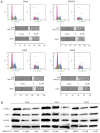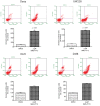MPS1 kinase as a potential therapeutic target in medulloblastoma
- PMID: 27633003
- PMCID: PMC5055207
- DOI: 10.3892/or.2016.5085
MPS1 kinase as a potential therapeutic target in medulloblastoma
Abstract
Medulloblastoma is the most common type of malignant brain tumor that affects children. Although recent advances in chemotherapy and radiation have improved outcomes, high-risk patients perform poorly with significant morbidity. Gene expression profiling has revealed that monopolar spindle 1 (MPS1) (TTK1) is highly expressed in medulloblastoma patient samples compared to that noted in normal cerebellum. MPS1 is a key regulator of the spindle assembly checkpoint (SAC), a mitotic mechanism specifically required for proper chromosomal alignment and segregation. The SAC can be activated in aneuploid cancer cells and MPS1 is overexpressed in many types of cancers. A previous study has demonstrated the effectiveness of inhibiting MPS1 with small-molecule inhibitors, but the role of MPS1 in medulloblastoma is unknown. In the present study, we demonstrated that MPS1 inhibition by shRNA or with a small-molecule drug, NMS-P715, resulted in decreased cell growth, inhibition of clonogenic potential and induction of apoptosis in cells belonging to both the Shh and group 3 medulloblastoma genomic signature. These findings highlight MPS1 as a rational therapeutic target for medulloblastoma.
Figures






References
-
- Wolter M, Reifenberger J, Sommer C, Ruzicka T, Reifenberger G. Mutations in the human homologue of the Drosophila segment polarity gene patched (PTCH) in sporadic basal cell carcinomas of the skin and primitive neuroectodermal tumors of the central nervous system. Cancer Res. 1997;57:2581–2585. - PubMed
MeSH terms
Substances
Grants and funding
LinkOut - more resources
Full Text Sources
Other Literature Sources
Molecular Biology Databases

